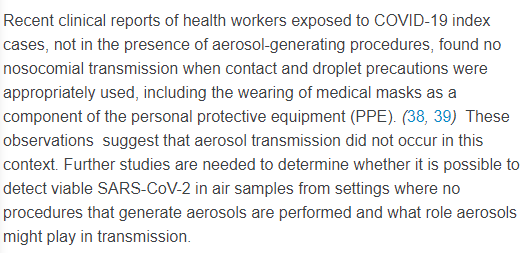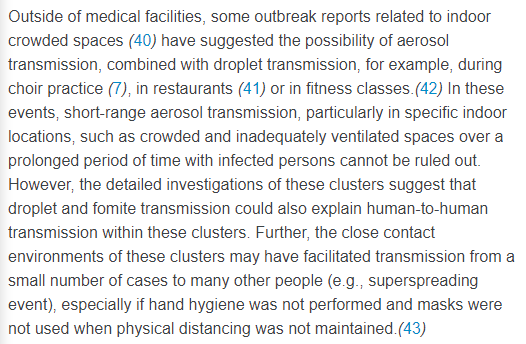People are saying "droplet" vs "aerosol" is semantic.
The WHO said aerosol scientists own vent companies.
I got upset.
A thread.
The WHO said aerosol scientists own vent companies.
I got upset.
A thread.
Let's go on a trip to WHO Scientific Brief land.
https://www.who.int/news-room/commentaries/detail/transmission-of-sars-cov-2-implications-for-infection-prevention-precautions
https://www.who.int/news-room/commentaries/detail/transmission-of-sars-cov-2-implications-for-infection-prevention-precautions
Errors in this section.
1. Respiratory droplets are >5-10uM, whereas droplets smaller than that are <5uM. The statement is that those above 5-10uM fall to the ground and those under float.
1. Respiratory droplets are >5-10uM, whereas droplets smaller than that are <5uM. The statement is that those above 5-10uM fall to the ground and those under float.
This is incorrect, as any aerosol scientist or engineer would tell you.
This textbook is from the 70s: https://twitter.com/jmcrookston/status/1294776432518995968
This textbook is from the 70s: https://twitter.com/jmcrookston/status/1294776432518995968
Here's another, showing how far the different size particles blow. https://twitter.com/jmcrookston/status/1294776435081699331
(Psst, I think the WHO got size of droplet floating vs not floating mixed up with the ones that go deep in the lungs, vs not. Don't tell anyone.) https://twitter.com/jmcrookston/status/1300825740317949952
2. The WHO runs with 1 meter here.
People are already aware other countries picked 2 meters. This is just an arbitrary distance.
People are already aware other countries picked 2 meters. This is just an arbitrary distance.
3. Droplet has to land directly on mouth nose or eyes.
There is not a single study proving this is the mode of transmission. If so, send me a copy ASAP.
There is not a single study proving this is the mode of transmission. If so, send me a copy ASAP.
4. Or by contaminating an object which someone else then touches (fomites). Again, not a single study proving this occurs. Yes, there are studies that show virus remains on surfaces for certain times,but respiratory viruses tend not to remain too long, and not on hands very long
4b. Very few of those studies show viable virus.
Pin this. I'll be back.
Pin this. I'll be back.
5. Airborne defined as long range.
Now this is interesting because means you have droplets over 1m, and then airborne over long range. Why can't you have small droplet over short ranges? Don't know.
Anyway the definition is wrong, as we saw.
Now this is interesting because means you have droplets over 1m, and then airborne over long range. Why can't you have small droplet over short ranges? Don't know.
Anyway the definition is wrong, as we saw.
6b. "These theories suggest"? Ha.
Also, again, sizes all wrong.
Also, they don't have to evaporate to the size to float. Everything under about 100uM floats.
For 4 billion a year, get the science right.
Also, again, sizes all wrong.
Also, they don't have to evaporate to the size to float. Everything under about 100uM floats.
For 4 billion a year, get the science right.
6c. Bunch of the usual criticisms to avoid aerosol:
- we don't know how many droplets exhale
- don't know infectious dose
- mention that SARS-CoV2 needs to be "viable" (grows) which is a usual complaint
(admit they know for other viruses, but
- we don't know how many droplets exhale
- don't know infectious dose
- mention that SARS-CoV2 needs to be "viable" (grows) which is a usual complaint
(admit they know for other viruses, but
6d. Here is the usual "cannot be airborne because did not culture viable virus". Also notes viral levels were low.
[Terminator]: I am now back. When swabbing fomites you often get negative results and/or low levels. But fomites are accepted.
Also, do not activate Skynet.
[Terminator]: I am now back. When swabbing fomites you often get negative results and/or low levels. But fomites are accepted.
Also, do not activate Skynet.
6e. Here is the usual "people didn't wear their masks properly and didn't get infected" which is a fallacy because lack of evidence is not evidence of lack of transmission.
6f. Possibility of aerosol transmission, and lists a bunch of areas.
If equally droplet, as they say, then why is the predominance INDOOR as they note? Hrm.
Aerosol would explain it.
If equally droplet, as they say, then why is the predominance INDOOR as they note? Hrm.
Aerosol would explain it.
The rest of the briefing note is too long to go through.
I don't doubt fomite, if important at all, is more important in high traffic areas such as hospitals. It is probably less relevant to individuals.
THAT SAID, WASH YOUR DIRTY HANDS YOU MONSTERS. It's cheap and easy.
I don't doubt fomite, if important at all, is more important in high traffic areas such as hospitals. It is probably less relevant to individuals.
THAT SAID, WASH YOUR DIRTY HANDS YOU MONSTERS. It's cheap and easy.
But let me revisit one thing:
- Respiratory viruses are exhaled.
- We inhale a certain volume of air with every breath.
- We are therefore inhaling a certain number of virions with every breath depending on location/ventilation.
- Respiratory viruses are exhaled.
- We inhale a certain volume of air with every breath.
- We are therefore inhaling a certain number of virions with every breath depending on location/ventilation.
- Being closer would expose us to higher concentration, which would account for close contacts.
- And would account for higher indoor vs outdoor
- And would explain some of the weird transmissions such as elevators
- And would explain the transmissions such as Hunan bus.
- And would account for higher indoor vs outdoor
- And would explain some of the weird transmissions such as elevators
- And would explain the transmissions such as Hunan bus.
My guess is that could account for almost all transmission via statistics of breathing out/in clouds of viruses, and the statistics of one penetrating our defences, as studies have investigated: https://twitter.com/jmcrookston/status/1303507048286560257
For further reading,
1. I wrote a thread where the authors found attack rate of rhinovirus (cold) the same w/ touching or not touching.
They they put the players in different rooms, although made playing cards "dripping wet" with mucus. NO infections. https://twitter.com/jmcrookston/status/1294689981815050240
1. I wrote a thread where the authors found attack rate of rhinovirus (cold) the same w/ touching or not touching.
They they put the players in different rooms, although made playing cards "dripping wet" with mucus. NO infections. https://twitter.com/jmcrookston/status/1294689981815050240
2. Measles, which is considered airborne, wasn't until we could not deny it. https://twitter.com/jmcrookston/status/1297250473448222720
3. TB, which is considered airborne, wasn't until we could not deny it. https://twitter.com/jmcrookston/status/1302772100860702724
4. Wells and Wells in the 30s laid out criticisms of these same arguments against aerosol, and refuted many of them almost 100 years ago. https://twitter.com/jmcrookston/status/1299386110070620165
Even Chapin in early 1900s, famously in favour of contact transmission, admitted that certain things were airborne at least the distance of a bed in a hospital.
He also felt more studies of airborne transmission needed.
And here we are 110 years later.
He also felt more studies of airborne transmission needed.
And here we are 110 years later.
Of course: Wash your hands. Distance. Wear masks. Not hard to do.
Just add, as much fresh air as possible please.
Just add, as much fresh air as possible please.

 Read on Twitter
Read on Twitter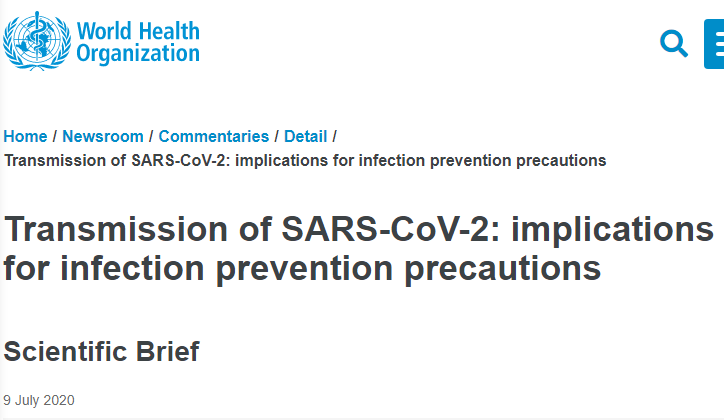





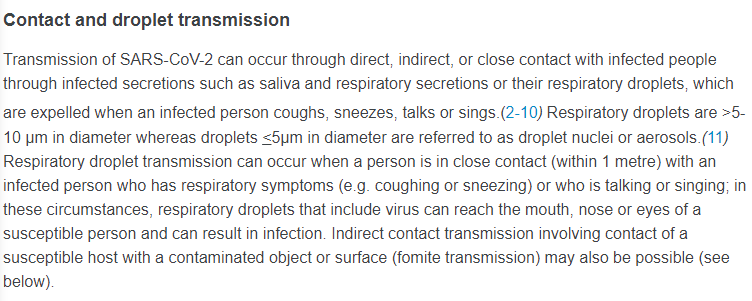









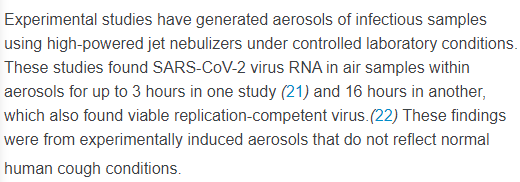
![6d. Here is the usual "cannot be airborne because did not culture viable virus". Also notes viral levels were low. [Terminator]: I am now back. When swabbing fomites you often get negative results and/or low levels. But fomites are accepted. Also, do not activate Skynet. 6d. Here is the usual "cannot be airborne because did not culture viable virus". Also notes viral levels were low. [Terminator]: I am now back. When swabbing fomites you often get negative results and/or low levels. But fomites are accepted. Also, do not activate Skynet.](https://pbs.twimg.com/media/EhhAgLFXkAA88cm.png)
